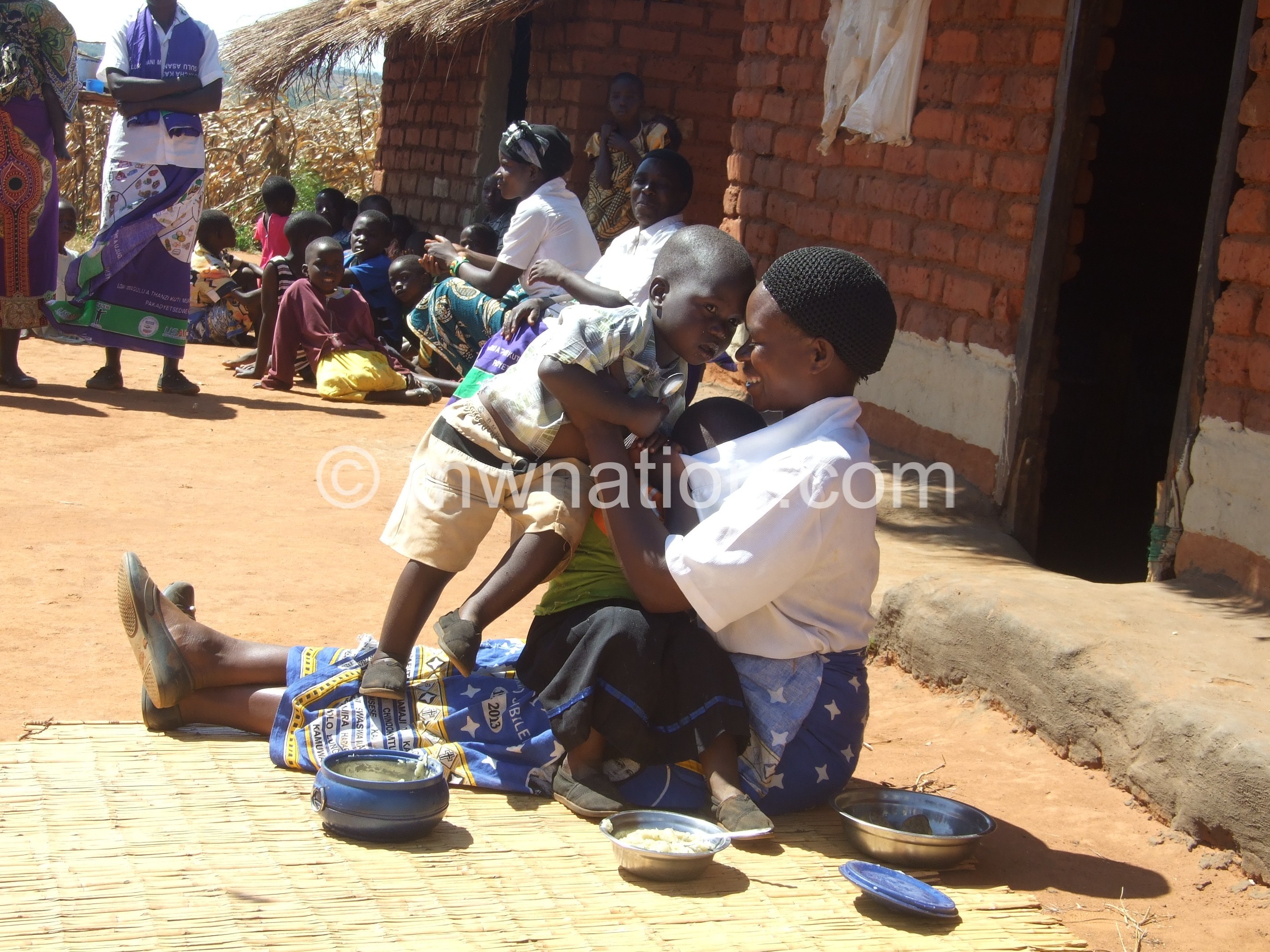Learning by doing saves children
New evidence shows training in diet diversity helps mothers tackle under-nutrition in Malawi, showing significant improvements in just three weeks, JAMES CHAVULA writes.
Every baby is a blessing, a cause for joy. However, Mary Banda, who lives in Kapokonyoka Village in Mzimba North West Constituency, was depressed the day she discovered that her twins were losing weight.

“We were happy to have twins in our family, but we had a rude awakening three months on when they lost weight. You could count their ribs. They looked pale, frail and sickly. Their hair was woolly,” she recalls.
Little did Banda know that the children were malnourished.
But the twins, who needed nutritional rehabilitation at Champhira Health Centre, quickly regained their weight and looked full of energy when she realised that no person can subsist on porridge derived from maize flour alone.
“A group of women, whom Feed the Future trained in making porridge containing all food values, urged me to diversify their diet. Without delay, I started giving my babies porridge made of a diversity of locally available foods, especially groundnuts, vegetables, fruits and meat.
The woman, who feared for the life of her children, personifies how training women to diversify their diets offers children a healthy start in life.
“It was shocking that they were stunting when a maize field in our backyard gives us a bumper harvest and they were having platefuls of porridge daily. My obsession with phala loyera put their lives in danger,” she says.
New evidence shows malnourished children under-two in rural Malawi whose mothers were trained in diet diversity, hygiene and food safety have shown significant improvements in their nutrition and health in just three weeks.
The study published in the Cambridge University Press’ Journal of Public Health Nutrition, demonstrates the rapid impact of properly designed nutrition education interventions.
Under-nutrition is a persistent problem in the country where overdependence on nsima and phala, meals made of ground maize, creates an imbalance in nutrition intake.
Most children in the country are living with harsh effects of malnutrition.
According to the 2015/16 Malawi Demographic Health Survey, about 37 percent of children are stunted.
Researchers from the International Crops Research Institute for the Semi-Arid Tropics (Icrisat) and the Lilongwe University of Agriculture and Natural Resources (Luanar) conducted the study in rural parts of Mzimba and Balaka has taken on this challenge.
“In just 21 days, children whose mothers were given comprehensive training on diversified complementary diets and Wash practices, and food safety, showed significant improvement in wasting, underweight and mid-upper arm circumference—all important measures of under-nutrition,” read the finding in part.
In this nutrition research, the scientists observed mothers of children aged under two years.
McKnight Foundation and the CGIAR Research Programmes on Agriculture for Nutrition and Health (A4NH) and Grain Legumes supported the study.
The findings point to new direction and approaches for achieving better health outcomes among children in low-income countries.
The lack of diet diversity is a major concern for the majority of Malawian families who are smallholder farmers, growing crops for both food and income. The United Nations’ Food and Agriculture Organisation (FAO) reports that more than half of the Malawian population lives in poverty, with high food insecurity.
Typically, farmers grow maize which constitutes their daily food. The almost always grow other crops for commercial purposes, with only recent interventions encouraging the use of millet and groundnuts for dietary diversity.
In the 2014-15 post-harvest season, the scientists ensured that 179 women under study used locally available foods and practices to develop a model that could significantly improve nutrition among young children.
“Using the food group approach, they developed a porridge recipe that combined nutritionally rich cereals and legumes like finger millet and pigeon peas, in addition to maize, groundnuts, carrots, amaranth leaves to complement breastfeeding and provide all amino acids and vitamins and minerals required for child growth,” reads the methodology.
Significantly, the researchers looked beyond knowledge transfer and zeroed on the participation of mothers who were already raising healthy children to lead cooking and training sessions for mothers with undernourished children.
Learning by doing has the benefit of using stakeholders’ knowledge and practices, in order to encourage adoption and ensure continued results outside the duration of the study.
Having worked with the mothers and their children, in-depth findings indicate the significant impact of low-cost nutrition, food safety and hygiene training and such simple practices can have on children’s health.
“While incidence of diarrhoea almost entirely disappeared, impact on wasting showed progressive improvements on days seven, 14, and 21, with the largest impact observed on the last,” reads the report.
There were similar trends though the study period was too short for observing effects on stunting.
“Using the ‘food group approach’ in addition to basic training on Wash practices, we were able to achieve significant improvements in measures of under-nutrition in just 21 days. If this model were to be scaled with the help of public and private development partners, the gains made could be significant in eradication malnutrition in Africa,” said Icrisat scientist Seetha Anitha who led the study.
The study also indicates a huge area of concern on food safety, since more than half the urine samples of children studied indicated aflatoxin contamination, though this did not exert significant effect on nutrition outcomes perse. n
Malawi’s mistake in power supply
Brian Ligomeka
G
lobally, reliable power supply is fundamental to the broader development agenda. Without electricity, it is not easy for the government to offer quality essential services.
The private sector also needs reliable electricity to manufacture quality products and offer world-class services. At household level, consumers connected to the grid yearn for consistent power supply all the time.
Erratic power supply usually triggers emotive reactions. It is no surprise that since July last year, many people have been complaining about Electricity Supply Corporation of Malawi (Escom) extended hours of load-shedding.
Unfortunately, instead of analysing the problem of blackouts with sober minds, we rushed to do what we know best – complaining, gossiping, lying, blaming and politicising the issue.
Politically-motivated tantrums have been flying around for months, with some pointing accusing fingers at President Peter Mutharika, Escom and ruling Democratic Progressive Party (DPP) for allegedly failing to end blackouts.
Some criticisms tend to ignore the fact that Mutharika has only been in power for four years.
Amidst the flurry of mumbling, the heartening development is that after analysing the gravity of the problem, government openly admitted that the country was indeed facing a power crisis. Without mincing words, Mutharika stated that the country has under-invested in the power sector for 53 years.
Whether one likes it or not, whether we are politically blue, green, orange, yellow or neutral, I find government’s explanation very valid. The power crisis we continue to endure is a result of our failure to invest substantially in the energy sector.
President Mutharika may have his own shortfalls, but his explanation that we under-invested in the power generation is the truth.
For arguments sake, let’s compare our power-generation capacity with those of our neighbours.
While our full generation capacity is around 352 megawatts (MW), Mozambique generates 2 300 megawatts. Zambia produces 1 900 and Tanzania generates 1 358. Malawi has the capacity to generate 352MW.
With this in mind, it is important to admit that previous regimes failed this country by not prioritising power generation.
The nation put all it ‘energy’ eggs in one basket as almost 99 percent of our power supply is hydro-based.
The consequence of over-relying on one source of power is what we are enduring now.
The country has suffered massive blackouts as the output of hydropower plants down the Shire River fluctuated between 135 and 200MW.
The cause of this crisis were consecutive droughts caused by El Niño that sapped water from Lake Malawi and the Shire to a critical low.
Whereas Malawi hugely depends on hydropower, the impact of climate change on power generation on our neighbours is minimal because they have diversified their sources of power.
Tanzania is a good example. Out of her total installed power capacity of about 1 358MW, 566.79 MW or 42 percent comes from hydro-power plants, 607 MW or 45 percent is from natural gas and 173.40 MW or 13 percent is from liquid fuel.
These are strategic investments Tanzania made in power generation.
As Mutharika said during the launch of gensets in Blantyre recently, diversified strategic investment in power generation is what Malawi failed to do in the past 50 years. This explains our current power woes.
Having identified our mistake, should we continue blaming our former presidents and ruling parties for failing to invest in power generation?
It is said that the best time to plant a tree was ten years ago. If you failed to plant one, then the second best time is now.
This is the best time to invest in multiple sources of power—extra hydro-power plants, cross-border power inter-connection, solar power, coal plants and fuel-powered gensets.
As this is being implemented, patience is needed because constructing and commissioning power plants do not take few months but rather few years. n





